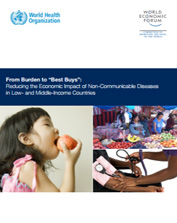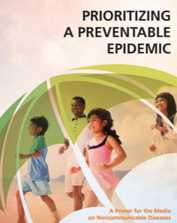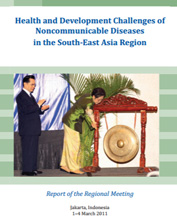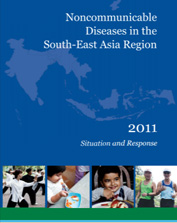
|
Post-UN NCD Summit Update
|
Post-UN NCD Summit Update
UN NCD High Level Meeting
Background
The United Nations ‘ Millennium Development Goals ( MDG) are 8 international development goals were signed in by United Nation member states in 2000 which commited world leaders to combat poverty, hunger, disease, illiteracy, environmental degradation, and discrimination against women. In 2011, the UN High Level Meeting ( UN HLM) was held. This was a momentum summit as the aim of the meeting was to adopt an action-oriented Declaration that would serve to shape national and global agendas in order for the international community to ‘take action” against the Non-Communicable Disease (NCD) epidemic -cardiovascular Diseases, cancer, chronic lung diseases and diabetes – which would impact the achievement of the MDG. At the UN HLM, the Political Declaration was adopted. The national plans to be in place by 2013 in order to curb the risk factors -(1)tobacco use,(2) alcohol consumption, (3)physical inactivity, and (4)salt intake-leading to the four NCDs) was adopted. A Global target has been set to reduce preventable deaths from NCD 25% by 2025 (see below).

Global Information
POST UN High Level MeetingThe member states are committed to take the first step to establish a national NCD policies by 2013. The World Health Organization (WHO) has called to submit ‘options for strengthening and facilitating multisectoral action’ and to prepare recommendations for voluntary targets to facilitate national framworks by the end of 2012. WHO is holding regional consultations and will be submitting their recommendations to the 2013 UN assembly. In order to achieve the Global target successfully, political leadhership and advocacy plays a significant role. It requires not only stakeholders but also civil society, academia and appropriate private sectors to get involved to acheive this target. Find out more about the Political Declaration |
CVD Facts in the Asia Pacific RegionHere is the alarming facts on Cardiovascular disease (CVD) . CVD caused 26.2% of deaths (3.9 million) in the South East Asia Region and 32.%.1 of deaths (4 million) in the West Pacific Region (WHO2002). Hyper tension is the most common CVD risk factor in Asia. Some 23 million people world wide have heart failure, and the prevelance is increasing quickly. Direct cost of CVD in Asia are estimated to exceed US $120 billion per year. By 2030, almost 23.6 million people will die from CVDs, mainly from heart disease and stroke. The annual loss of approximately US$ 500 billion amounts to roughly 4% of GDP for low- and middle-income countries in 2010. Non-communicable diseases does not only threat many lives but also puts a significant burden on our economy as well. The good news is CVD is 80% preventable and devastation caused by tobacco use can be reversed. Be aware! Get invovled! Protect your life & your family! |
The Next Step for the Asia Pacific Region
CVD is a No.1 cause of death in the Asia Pacific region and there are number of challenges invloved in NCD (CV, cancer, diabetes, and chronic lung disesases). Policy makers must be convinced that NCD is a public health issue and if we do not take action to get all the policy makers, media, private sectors and civil societies involved to control risk factors , the number of death is only going to increase, quality of life of people will significantly lower, and economic burden will only worsen. The action plan for the Asia Pacific region is to work at a whole-of-society “multisectoral” approach with a whole-of-government response. This is to involve at all levels from various sectors, from the food industry to finance ministry. The policy levers for reducing risk factors are in non-health sectors as agriculture, trade, industry, food processing, education, urban planning. See our Regional Plan on Tobacco Control here
What is the Millennium Development Goals?Click on the image to see more information. |
FCTC Conference of Parties (COP) & Intergovernmental Negotiation Body (INB)COP is the governing body that regularly reviews the implementation of the Convention and takes the decisions necessary to promote its effective implementation, and may also adopt protocols, annexes and amendments to the Convention. INB is one of the subsidary bodies on a Protocol on Illicit Trade in Tobacco Products. There has been 4 COP meetings and 5 INB meetings held as to date. To follow all governing body meeting outcomes, see the following documents: |
||||
FCTC & MPOWER
|
|||||
WHO Indicators & Targets / Best BuyCVD can be prevented. The leading risk factors for death around the world are raised blood pressure, tobacco use, raised blood glucose, physical inactivity, and overweight and obesity. After the UN High Level Meeting, the proposed target to meet our overarching goal reduce premature NCD deaths 25% by 2025 was announced and the 10 indicators & targets were proposed to meet this goal. Click the image to enlarge |
Best BuyCumulative economic losses to low-and middle-income countries from NCDs are estimated to surpass US$7 trillion over the period of 2011-2025 (an average of nearly US$ 500 billion per year). The social burden associated with NCD is not just a public health issue but also an economic one. The social costs of NCDs and the resource needs for managing these conditions, WHO has identified a set of evidence-based “Best buy” intervention that are not highly cost -effective but also feasible and appropriate to implement within the constraints of the local LMIC health systems.
|
||||
WHO 2008-2013 Action Plan & Objectives of the 2013-2020 Action Plan
|
|||||
Asia Pacific Region Information
| Post UN Summit (Schedule from 2012-2013)
Asia Pacific Region Multi Sectoral Approach
|
Quick Review on WHO's Discussion Papers & Principle NCD Meetings
|
APHN Heart Charter & Regional Plan
The APHN Heart Health Charter is to help stem the growing burden of CVD and its social & economic imapct on the region’s four billion inhabitants.
APHN has developed a Tobacco Control Regional Plan with an over-arching goal: A tobacco-free region where less than 5% of the population smokes.
For further Information on Advocacy information & toolkits, please visit our “Advocacy” section
Useful References
** All materials are resources by the World Health Organization (Geneva, South-East Asia, Western Pacific ) and World Heart Federation.















